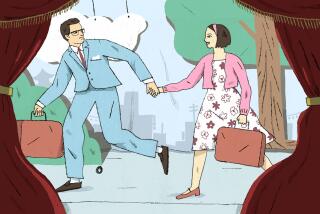Review: Little drama in ‘Act One’; still, there’s some good theater
Whenever a thespian, young or old, needs some inspiration, I always prescribe the same two books: “The Mystic in the Theatre: Eleonora Duse” by Eva Le Gallienne and “Act One” by Moss Hart.
Both works offer testimony to the rocky shoals and spiritual rewards of a life in the theater. “Act One,” the story of a poor outer borough New York City kid realizing his dream of the Broadway big time, is cherished additionally for its portrait of a bygone era of a bustling American theater dominated by prodigious wits and garish, hustling impresarios.
Hart’s beloved memoir cries out for dramatization, but the awful 1963 movie version with George Hamilton as the fledgling playwright apprenticing at the feet of Jason Robards’ George S. Kaufman stands as a warning to all who make the attempt.
PHOTOS: From screen to stage: Musical movie adaptations
James Lapine, who adapted and directed the new version at Lincoln Center Theater’s Vivian Beaumont, would seem to be the right man for the job. An ace collaborator of Sondheim’s, Lapine has worked closely with latter-day giants, has sharp theatrical instincts and has no doubt compiled a rich trove of Broadway lore.
But there’s a fundamental problem in bringing “Act One” to the stage: The episodic story isn’t structured as a drama. There’s tension but little suspense. Anyone who knows the vaguest thing about Hart will know that he became one of the 20th century’s major Broadway figures, a playwright and director best known for the plays he co-wrote with Kaufman, including “The Man Who Came to Dinner” and “You Can’t Take It With You.”
The narrative, centering on the arduous birth of “Once in a Lifetime,” the 1930 play he wrote with Kaufman that was Hart’s first major success, guarantees a happy ending. That foreknowledge doesn’t impede one’s interest in the memoir, which pulls the reader along with its Dickensian New York characters, loud family meshugas and the rags-to-riches travails that continue to lure theatrical dreamers to New York
PHOTOS: Best in theater for 2013 | Charles McNulty
But on stage this roller coaster journey, unable to induce butterflies of excitement, seems unduly repetitive. The book hasn’t been distilled into a workable dramatic form. But then artists blundering through the process of creation, with its false starts and agonizing reversals, isn’t the most inherently theatrical of subjects.
On a giant turntable set, designed by Beowulf Boritt (no doubt planned with Lapine as a homage to Hart’s signature method of staging such classics as “My Fair Lady” and “Camelot”), the story whirls about in a rapid succession of scenes that could desperately use another round of editing. A person could get dizzy watching this merry-go-round, especially with Louis Rosen’s somewhat heavy-handed music intensifying the sense of vertigo.
But there are rewards to the production. Three actors play Moss Hart: Matthew Schechter is young Hart, Tony Shalhoub is the older Hart looking back, and Santino Fontana is the anxious, eager-beaver acolyte Hart determined to conquer the Great White Way. All three are terrific, but Shalhoub, who also plays Hart’s father as well as a highly neurotic George S. Kaufman (who has some of the same compulsive tendencies as Shalhoub’s TV character Monk) is outstanding.
PHOTOS: Hollywood stars on stage
Much of the rest of the cast, not granted the luxury of time in the storytelling swirl, is reduced to broad strokes. Andrea Martin as Hart’s Aunt Kate, who infected him with her love of the theater before being banished from the cramped apartment by his father, can only leave an impression of the sorrow that would both spur and stymie Hart throughout his glorious career.
What is most memorably re-created is the bond between Shalhoub’s Kaufman and Fontana’s Hart, one theater artist seeing the potential in another and extending the life rope not of mentorship but of genuine collaboration. If the portrayal of this bromance, grounded in the frustration and resolve of shared creative work, can bring a new generation of theater people to Hart’s indelible memoir, then Lapine’s production will have been worth the effort.
More to Read
The biggest entertainment stories
Get our big stories about Hollywood, film, television, music, arts, culture and more right in your inbox as soon as they publish.
You may occasionally receive promotional content from the Los Angeles Times.







